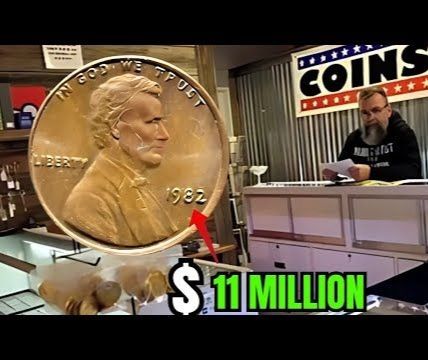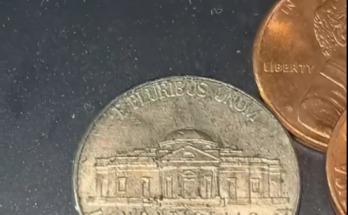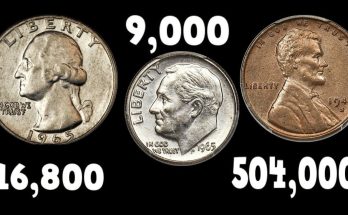💰 The $11 Million Penny Hype: The Rare 1982 Varieties
The year 1982 is a crucial “transition year” in the history of the Lincoln Cent, which makes it a treasure hunter’s favorite. Before this year, the penny was predominantly bronze (95% copper), weighing about 3.11 grams. Starting in late 1982, the U.S. Mint switched to a cheaper copper-plated zinc composition, weighing only about 2.5 grams. This compositional change, combined with a concurrent change in the size of the date inscription (“Large Date” vs. “Small Date”), resulted in seven different varieties of the 1982-dated penny.
The true multi-thousand-dollar rarity the image is likely referring to is the 1982-D Small Date Copper Cent.
- What Makes It Rare? A small number of bronze planchets (the 3.11g copper composition) were mistakenly struck with the Denver Mint’s “D” mark and the “Small Date” die after the mint had officially switched to the zinc planchets. This coin should not exist.
- The Estimated Value: While the $11 Million figure is a sensationalized exaggeration often used for clickbait in the collecting world, the genuine error coin—the 1982-D Small Date Copper Penny—is indeed highly valuable and extremely scarce. One authenticated, high-grade example is believed to be worth tens of thousands of dollars, with some reports mentioning past estimates as high as $18,000 or more for an exceptional find. Its true market value would be determined at auction.
The key to finding this rarity is to weigh the 1982-D Small Date penny. If it weighs 3.11 grams, it’s the copper composition and a potential jackpot. If it weighs grams, it’s the common zinc variety.
🌟 Top 10 Dirty Pennies: Other Lincoln Cents That Could Make You Rich
Beyond the sensational 1982-D copper error, the world of Lincoln pennies is filled with other rare varieties, key dates, and mint errors that are worth significant money. Finding any one of these “dirty pennies” in a jar of change or an old collection could be life-changing.
Here are a few of the most valuable Lincoln Cents that are often cited in “Top 10” lists, which a treasure hunter should look for:
- 1943 Copper/Bronze Cent: The most famous penny error. Pennies were struck in zinc-coated steel in 1943, but a few copper planchets were struck by mistake. Values can exceed $1 Million!
- 1944 Steel Cent: The reverse of the 1943 error—a few steel cents were accidentally struck in 1944 (a year for copper). Highly valuable, sometimes worth hundreds of thousands of dollars.
- 1909-S VDB: The first year of the Lincoln Cent, with the designer’s initials “VDB” prominently on the reverse, and a very low mintage at the San Francisco Mint (“S”). Highly sought after, with top grades fetching over $100,000.
- 1955 Doubled Die Obverse (DDO): A highly visible error where the date and lettering are clearly doubled. Can be worth upwards of $40,000 in high grades.
- 1969-S Doubled Die Obverse (DDO): An even rarer DDO with strong doubling on the date and “LIBERTY.” Top examples have sold for over $126,000.
- 1972 Doubled Die Obverse (DDO): Another significant doubling error that is clearly visible. Valued in the thousands of dollars.
- 1914-D Lincoln Cent: A rare “Key Date” with a very low mintage from the Denver Mint. In good condition, it’s worth thousands of dollars.
- 1983 Doubled Die Reverse (DDR): Doubling on the lettering on the reverse side. Valuable, with uncirculated pieces selling for thousands of dollars.
- 1992 Close AM: A modern variety error where the “A” and “M” in AMERICA on the reverse are touching or very close. Rare examples have sold for over $20,000.
- 2000-P Wide AM: Another modern variety error, the reverse of the ’92 Close AM, where the letters “A” and “M” in AMERICA are spaced wider than they should be for the year. Worth hundreds of dollars and more in top condition.
The image serves as an exhilarating reminder that the true value of a coin is often hidden in its rarity, condition, and a simple mistake by the US Mint. While the majority of cents are worth just a penny, the possibility of discovering a transitional error like the 1982-D Small Date Copper Cent or a famous Doubled Die makes checking your pocket change and coin jars a rewarding hobby.
Would you like me to focus the description on the specific identification steps for the rare 1982 pennies (Large vs. Small Date, Copper vs. Zinc) or search for recent auction results for the 1982-D Small Date Copper penny?



